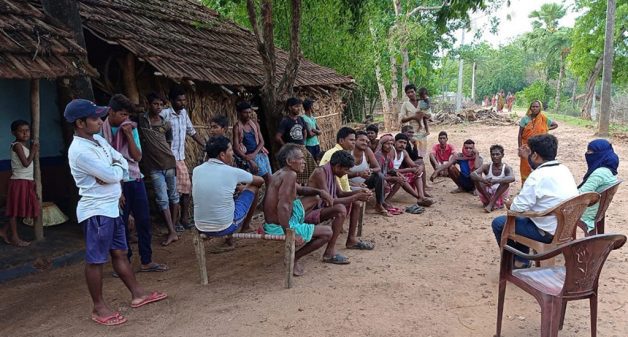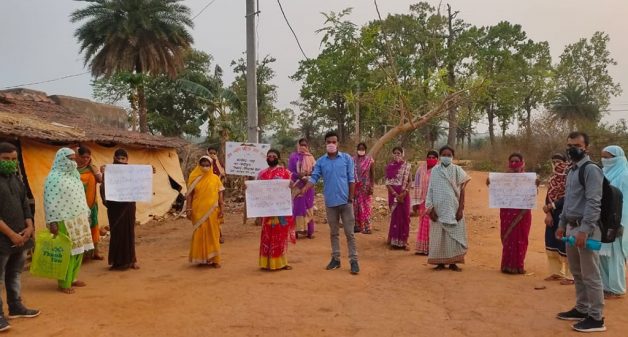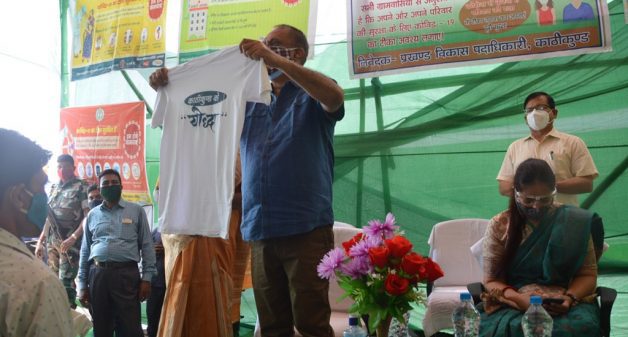
Villagers’ fear of vaccines wanes slowly with awareness
Counselling and convincing various village influencers, and encouraging youth volunteers on their campaign drives have helped communities get past rumors and fears to get vaccinated

Counselling and convincing various village influencers, and encouraging youth volunteers on their campaign drives have helped communities get past rumors and fears to get vaccinated
“You people have brought this disease to our village. Earlier we had no such disease. And now you plan to kill us with these vaccines.” Such were the words of Jharkhand’s villagers who genuinely believed that healthcare workers had brought the disease and that the vaccine would kill them. That was why they refused to get vaccinated.
Dependency on medicine men or quacks for treatment, the influence of local religious leaders, unavailability of adequate medical infrastructure and many other reasons have caused greater fear among the tribal communities of the state.
The task forces, comprising accredited social health activists (ASHAs), anganwadi workers, auxiliary nurse midwives (ANMs) and self-help group (SHG) members faced strong opposition to the vaccination drive. Officials in remote villages have to battle not only the pandemic but also the misinformation and rumors. Their strategies to overcome these challenges are slowly bearing results.
Derailed plans
On 1 March 2021, a vaccination drive against COVID-19 for people above 45 years was initiated in the tribal villages of Jharkhand. Walk-in vaccination centers were set up in the panchayats for an estimated target population of 83 lakhs.
The vaccination drive was strategically focused to involve the manjhi (headman) and other leaders of traditional local governance system to mobilize the villagers. However, the massive spread of the second wave resulted in fear among the people, jeopardizing the efforts of the state government.

The villagers feared the side effects of the vaccine and blamed the vaccination drive for the sudden spread of COVID-19 and the adverse health conditions in their villages. Bureaucrats had a hard time convincing the tribes to take the shots.
Vaccine myths
Those who had taken the first dose were slipping into a chasm of anxiety and mistrust about taking the second dose. Battling the spread of COVID-19 was one major concern; the other was to change the mindset of the villagers, who resisted taking the vaccine, believing in the myth that it would kill them.
In Dumka district of Jharkhand, the estimated target population in the 45+ age group is about 3.35 lakhs. In Kathikund administrative block, the target was 18,111. During the first phase, which ended on 31 March 2021, almost 8.5% of the target population, that is, 1,540 people were vaccinated in the block. People continued to get vaccinated till the end of first phase.
However, there was a drastic change from the beginning of April when a large number of people fell sick, a normal reaction to the vaccine. This resulted in people fearing the vaccine, and it generated strong resistance and misconceptions among them. The fearful villagers started threatening frontline workers and health workers in the villages.
Myth-busting strategies
On 3 April 2021, seeing the chaos and mistrust that surrounded the vaccine, the block administration called for a joint meeting with Professional Assistance for Development Action (PRADAN) and other partners who were facilitating the drive. At the meeting we prepared a detailed strategy for Kathikund block, to overcome the challenge emerging out of the misconceptions.
PRADAN surveyed casualties and post-vaccine deaths in order to compile data. The results were shared with the district administration. This was the first level of data that provided the block and district administration the exact situation on the ground.
The data showed that there indeed was a real reason for fear among the people: six people had died within two weeks of taking the vaccine. However, what is pertinent is that those who died had reportedly been ill prior to their vaccination. Yet they had been vaccinated.
The news of the deaths was enough to give rise to rumors about the adverse effects of the vaccine. To eradicate this fear, a stringent post-vaccination system was set up. To be doubly sure, PRADAN’s panchayat facilitators were roped in to work with the frontline workers in dissipating fears.
The block administration tracked the people who had been vaccinated, so as to get medical help if anyone got severely ill after vaccination. If one had fever, paracetamol was given; if there was no improvement, then we referred them to hospitals and arranged ambulance to take them.
Rallying influencers
There was also a lack of awareness about COVID-19 besides lack of adequate healthcare facilities. The villagers ignored their fever, cough and other symptoms till the conditions got worse. Then they turned to the local quacks, who reportedly administered medication for typhoid and jaundice.
When the block administration learnt about it, it called for an urgent meeting with the quacks and the medical officer in charge of the community. Unlike the traditional healers, quacks prescribe allopathy medicines. They are often the nearest recourse for the villagers.
The doctor explained about the disease, and shared information about the symptoms and steps to be taken if infected. Though unregistered, as the community depends on them, the doctor and the block development officer convinced the quacks to prescribe appropriate medicines. Armed with the right information, they agreed to help us in the vaccination drive too.

We had separate meetings with 25 quacks, 72 religious leaders of different religions and 80 community leaders. The religious leaders and faith-based groups could not be convinced as easily as the quacks. Initially, it was difficult to even reach the local religious leaders.
Two meetings with the priests did not yield any results. “We will not ask people to take the vaccine nor will we take it ourselves. Whatever happens, god will take care of us,” said a local priest from Sikarpara village in Kathikund block.
They resisted getting vaccinated and making the community aware. A few religious leaders, however, were convinced and led the way by taking the vaccine and by asking others to get vaccinated. These religious leaders built some faith in the community by showing the way.
Community collectives’ support
SHG members played a significant role in the vaccination awareness drive. Since they are a part of the local community, language was not a barrier for them. The local communities could relate to them, engage with them and were more open to listening to their advice.
Therefore, these community leaders emerged as a great support system, inspiring other eligible SHG members to come forward and join the vaccination drive. In Kathikund block, the board members of block-level federation Naya Savera were among the first of the 45+ age group to get vaccinated against COVID-19.
Youth volunteers’ campaign
The participation of the local youth in any awareness drive plays a crucial role because they can pass on correct information through their smartphones in no time. They are also familiar with the rural ecosystem. However, this has its own risks as false rumors could also be spread through smartphones. Therefore, we invited a few youth who had some positive influence among the tribal community for a meeting.
The local youth organized awareness camps in the villages and at the same time launched a social media campaign, #KathikundKeYoddha – meaning warrior of Kathikund, to promote vaccination. The campaign, which included T-shirts with a printed slogan, soon reached many when the portal opened for the 18+ age group.

Many young people uploaded their post-vaccination pictures on social media platforms and the campaign helped lowering the fear of vaccines among the tribes. Deputy commissioner and deputy development commissioner, Dumka appreciated the awareness campaign led by the youth.
Facilitating vaccination
Reaching remote locations is another obstacle we worked on. People live in remote villages in the Kathikund region. Women found it difficult to travel from far-off villages to vaccination centers. To resolve this issue, three auto rickshaws were arranged to ferry them from these villages to the vaccination centers. This initiative increased their mobility and the vaccination.
The scarcity of technological resources and the lack of knowledge on how to use it were other barriers when the CoWIN portal was introduced. Initially we roped in rozgar sevaks who facilitate MGNREGA works, poshan sakhis who work towards better nutrition intake among communities, and panchayat facilitators to help people register, after training them; however, this did not work out as expected.

The block administration introduced a registration counter-cum-help desk to enable walk-in vaccinations. Kathikund became the first block in the district that initiated this system. Later, the state government replicated this method in all other blocks.
Successful multipronged strategy
Kathikund achieved 46% vaccination coverage on 5 June, whereas the other blocks in Dumka such as Gopikand block covered only 36% and Sikarpara block vaccinated 26% of its population. Kathikund achieved this by following the strategy explained above.
We have a long way to go. There are seven villages in Kathikund block that have achieved 100% vaccination in the 45+ age category. By 25 June 2021, 52% of the people in the 45+ age group and 4% in the 18+ age group had taken the vaccine shots.
The availability of vaccines for the 18+ group is a major issue. Due to unavailability of vaccines, Kathikund block had to shut its centers for a few days. Anti-social elements still spread rumors and anti-vaccination messages through various modes.
Despite such challenges, Kathikund has shown that tracking rigorously, generating awareness and counselling local people helps in combating these fears to a great extent. The coming together of SHGs, local healers, religious leaders and youth, to mobilize the community is a lesson that can be taken forward in India’s drive for total vaccination in rural areas.
Alok Kumar Sharma is an executive working in PRADAN. He is based in Dumka. He has a master’s degree in social work from the University of Delhi. Views are personal. Email: Alokkumarsharma48@gmail.com